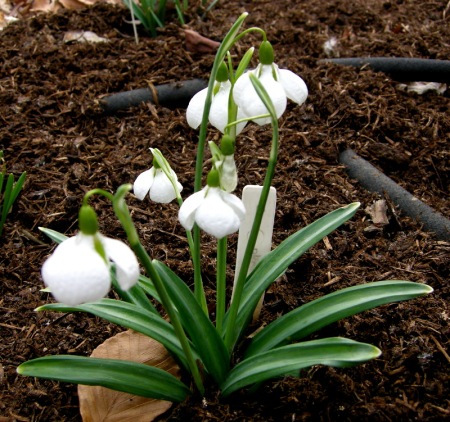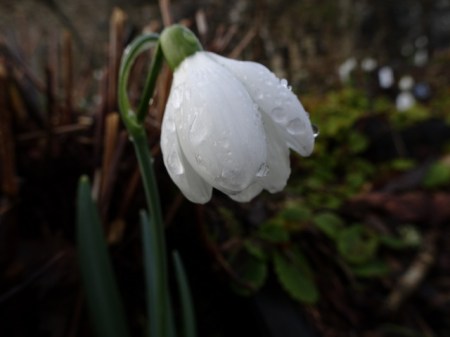Carolyn’s Shade Gardens is a retail nursery located in Bryn Mawr, PA, specializing in showy, colorful, and unusual plants for shade. The only plants that we ship are snowdrops to the US only. For catalogues and announcements of local events, please send your full name, mailing address, and cell number to carolyn@carolynsshadegardens.com and indicate whether you are mail order only. Click here to get to the home page of our website for catalogues and information about our nursery and to subscribe to our blog.
.
 Number 12: ‘Walrus’, a very striking double common snowdrop (Galanthus nivalis) with narrow green outer segments arching like the tusks of a walrus and very green and regular inner segments forming a rosette, selected in the 1960s.
Number 12: ‘Walrus’, a very striking double common snowdrop (Galanthus nivalis) with narrow green outer segments arching like the tusks of a walrus and very green and regular inner segments forming a rosette, selected in the 1960s.
Our current snowdrop catalogue is on line here.
In Part One of this post, I explained that although the basic ornamental characteristics making up snowdrop plants may seem limited, over 1,000 cultivars (some say as many as 1,500) have been selected. For gardeners who are just starting to add snowdrops to their collection, the choices can seem daunting. However, a recent survey conducted by Avon Bulbs, the well-respected British snowdrop nursery, can help with the process.
.
 ‘Walrus’ looks very pretty from the top, and it is easy to see the ‘tusks’ that give it its name.
‘Walrus’ looks very pretty from the top, and it is easy to see the ‘tusks’ that give it its name.
During the 2012 and 2013 snowdrop season, Avon Bulbs asked its customers from all over the European Union to choose their three favorite snowdrops. Avon then produced a ranking of its customers’ 25 favorite snowdrop plants. In Part One of this post, which you can read here, I profiled Numbers 13 through 25 and provided a photo or link to a photo for each plant. In this post, I will show you the top 12 snowdrops.
Note: When I don’t have my own photo, I have linked to photos provided on the wonderful website Judy’s Snowdrops, which I highly recommend as a source for snowdrop information.
.
 Number 11: ‘South Hayes’, first seen in 1992 in Primrose Warburg’s garden and probably a seedling of ‘Trym’ (number 3), one of the most sought after snowdrop bulbs for its distinctive pagoda-like shape and very unusual dark green markings. Available in 2019 CSG catalogue.
Number 11: ‘South Hayes’, first seen in 1992 in Primrose Warburg’s garden and probably a seedling of ‘Trym’ (number 3), one of the most sought after snowdrop bulbs for its distinctive pagoda-like shape and very unusual dark green markings. Available in 2019 CSG catalogue.
.
 Number 10: ‘John Gray’, a beautifully marked, full and perfect flower hung on a graceful, long arching pedicel (flower stem), first offered for sale in 1967. It is interesting to note that the snowdrop “bible”, Snowdrops: A Monograph of Cultivated Galanthus by Matt Bishop et al., first published in 2001, says the following about ‘John Gray’:
Number 10: ‘John Gray’, a beautifully marked, full and perfect flower hung on a graceful, long arching pedicel (flower stem), first offered for sale in 1967. It is interesting to note that the snowdrop “bible”, Snowdrops: A Monograph of Cultivated Galanthus by Matt Bishop et al., first published in 2001, says the following about ‘John Gray’:
There can be no doubt that a survey of galanthophiles’ favourite snowdrops would place ‘John Gray’ in the top ten, a position it would maintain among the current wide range of cultivars despite its age.
.
 Number 9: ‘Atkinsii’, an early-blooming and quite vigorous hybrid with large, robust flowers sporting a heart-shaped marking on the inner segment, originated in the 1860s.
Number 9: ‘Atkinsii’, an early-blooming and quite vigorous hybrid with large, robust flowers sporting a heart-shaped marking on the inner segment, originated in the 1860s.
.
 A close up of ‘Atkinsii’, which Snowdrops says has “elegant elongated flowers that suggest the drop-pearl earrings of Elizabeth I.”
A close up of ‘Atkinsii’, which Snowdrops says has “elegant elongated flowers that suggest the drop-pearl earrings of Elizabeth I.”
.
 Number 8: ‘Three Ships’, an early flowering Crimean snowdrop (Galanthus plicatus) with lovely rounded, well-proportioned flowers displaying a wonderful puckered texture on the outer segments, found in 1984.
Number 8: ‘Three Ships’, an early flowering Crimean snowdrop (Galanthus plicatus) with lovely rounded, well-proportioned flowers displaying a wonderful puckered texture on the outer segments, found in 1984.
.
 Number 7: ‘Augustus’, the plump, well-rounded flowers with great texture are set off perfectly by the lovely pleated leaves of a Crimean snowdrop for an overall great presentation, named prior to 1976.
Number 7: ‘Augustus’, the plump, well-rounded flowers with great texture are set off perfectly by the lovely pleated leaves of a Crimean snowdrop for an overall great presentation, named prior to 1976.
.
 A close up of ‘Augustus’ showing its elegant textured petals and large inner mark.
A close up of ‘Augustus’ showing its elegant textured petals and large inner mark.
.
 Number 6: ‘Mrs. Macnamara’, an early-flowering giant snowdrop (Galanthus elwesii) combining all the fine characteristics of a classic snowdrop, frequently mentioned as a favorite on garden blogs.
Number 6: ‘Mrs. Macnamara’, an early-flowering giant snowdrop (Galanthus elwesii) combining all the fine characteristics of a classic snowdrop, frequently mentioned as a favorite on garden blogs.
.
 Number 5: ‘Wendy’s Gold’, a Crimean snowdrop (G. plicatus) cultivar with beautiful yellow markings on the ovary and inner segments. Available in 2019 CSG catalogue.
Number 5: ‘Wendy’s Gold’, a Crimean snowdrop (G. plicatus) cultivar with beautiful yellow markings on the ovary and inner segments. Available in 2019 CSG catalogue.
.
 Alan Street from Avon Bulbs sent me this photo of a clump of ‘Wendy’s Gold’, saying that mine would look like this some day!
Alan Street from Avon Bulbs sent me this photo of a clump of ‘Wendy’s Gold’, saying that mine would look like this some day!
.
 Number 4: ‘Diggory’, a snowdrop I would recognize anywhere for its squared-off pear-shaped flowers, heavily quilted texture, and large green inner mark. Available in 2019 CSG catalogue.
Number 4: ‘Diggory’, a snowdrop I would recognize anywhere for its squared-off pear-shaped flowers, heavily quilted texture, and large green inner mark. Available in 2019 CSG catalogue.
.
 This clump of ‘Diggory’ shows its unique look and the pleated leaves characteristic of a Crimean snowdrop.
This clump of ‘Diggory’ shows its unique look and the pleated leaves characteristic of a Crimean snowdrop.
.

Number 3: ‘Trym’, the first snowdrop selected for the combination of its unique pagoda-like shape and large marks on the outer segments, it is obviously still very popular even though other snowdrops like its descendant ‘South Hayes’ now exhibit this form. Available in 2019 CSG catalogue.
.
 Number 2: ‘Magnet’, a very vigorous classic snowdrop selected in the 1880s with a long and slender pedicel allowing the flower to sway in the slightest breeze. Available in 2019 CSG catalogue.
Number 2: ‘Magnet’, a very vigorous classic snowdrop selected in the 1880s with a long and slender pedicel allowing the flower to sway in the slightest breeze. Available in 2019 CSG catalogue.
.
 A close up of ‘Magnet’ showing its arching pedicel.
A close up of ‘Magnet’ showing its arching pedicel.
.
 Number 1: ‘S. Arnott’, large rounded, sweetly scented flowers with a heart-shaped green marking on the inner segment. The book Snowdrops has this to say about ‘S. Arnott’:
Number 1: ‘S. Arnott’, large rounded, sweetly scented flowers with a heart-shaped green marking on the inner segment. The book Snowdrops has this to say about ‘S. Arnott’:
In fifty years time it will be interesting to see which of the newer snowdrops described in these pages will still be going strong, having established a reputation as a first-class garden plant with an unquestionable constitution, admired by everyone. Such is this classic snowdrop.
Available in 2019 CSG catalogue.
.
 ‘S. Arnott’ displays its “unquestionable constitution”.
‘S. Arnott’ displays its “unquestionable constitution”.
.
It is interesting to note that six of the twelve top ranked snowdrops are descended from the Crimean snowdrop, G. plicatus. And seven of the top twelve display what I would call a traditional snowdrop look with nothing “newfangled” about them. As with numbers 13 through 25, the top twelve ranked snowdrop bulbs show that, in the long run, classic and vigorous garden plants are more highly valued by knowledgeable collectors than the latest hot snowdrop off eBay. I find this refreshing in a horticultural world that often seems to discount the tried and true in favor of the latest fad.
Carolyn
If you are looking for more information on snowdrops, I highly recommend the Scottish Rock Garden Club forum galanthus thread where galanthophiles from all over the world meet to obsess about snowdrops, click here.
.
Note: Every word that appears in orange on my blog is a link that you can click for more information. If you want to return to my blog’s homepage to access the sidebar information (catalogues, previous articles, etc.) or to subscribe to my blog, just click here.


 Number 23:
Number 23: 



 Number 18:
Number 18: 

 Number 15:
Number 15: Number 14:
Number 14: Number 13:
Number 13: 




















